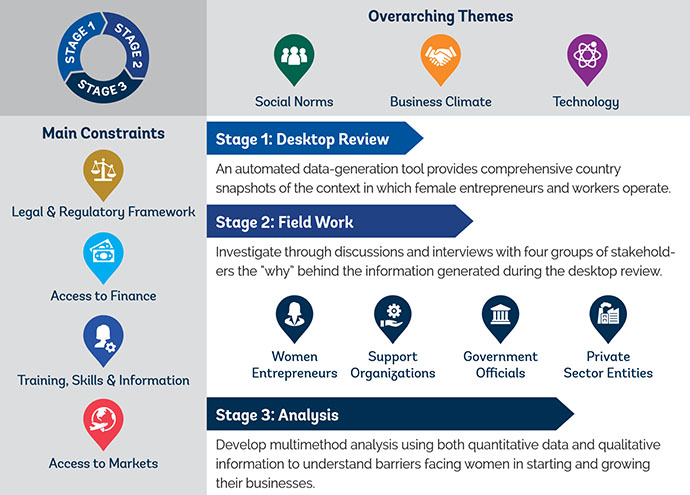The Diagnostic Process
This section outlines a systematic approach project teams can use to identify a country’s predominant constraints to female entrepreneurship. It consists of two parts. The first is a desktop diagnostic tool that provides access to a comprehensive set of indicators, organized into seven categories (social norms; business climate; legal and regulatory frameworks; access to finance; training, skills, and information; access to markets; and access to technology), that can be used to detail the quantitative dimensions of female economic participation, along with a Data Analysis Guide (see Appendix 2) to facilitate review and interpretation of the data. The second part consists of guidance for conducting field-based research to obtain qualitative information derived from focus group discussions and interviews across four stakeholder groups: (a) women entrepreneurs;9 (b) government officials; (c) support organizations that work with entrepreneurs; and (d) private sector entities. The collected information is used as input into program design or to recommend policy reforms that support female entrepreneurship.
This section outlines a systematic approach project teams can use to identify a country’s predominant constraints to female entrepreneurship. It consists of two parts. The first is a desktop diagnostic tool that provides access to a comprehensive set of indicators, organized into seven categories (social norms; business climate; legal and regulatory frameworks; access to finance; training, skills, and information; access to markets; and access to technology), that can be used to detail the quantitative dimensions of female economic participation, along with a Data Analysis Guide (see Appendix 2) to facilitate review and interpretation of the data. The second part consists of guidance for conducting field-based research to obtain qualitative information derived from focus group discussions and interviews across four stakeholder groups: (a) women entrepreneurs; (b) government officials; (c) support organizations that work with entrepreneurs; and (d) private sector entities. The collected information is used as input into program design or to recommend policy reforms that support female entrepreneurship.

The desktop indicator set draws on pertinent databases, statistics, and online reports. The field-based research is based on a set of discussion guides (see Appendix 4) for each of the stakeholder groups and is meant to be deployed either through focus group discussions or in individual interviews. Findings from field research provide nuanced insights and information that cannot be captured through quantitative research and analyses alone. This two-step process, by providing empirical data and primary source information about the context in which women operate their businesses, guards against the possibility that preconceptions and bias will influence project design and policy advice. It also ensures comprehensive stocktaking across pertinent topics and stakeholders. When analyzed together, desktop indicators and answers to field-based questions will yield a rich contextual understanding of the environment in which women entrepreneurs operate their businesses.
The desktop research provides a rapid assessment and analysis that facilitates and helps guide the country diagnostic process. It also supports and systematizes the review of comparable global data and benchmarking. For the in-country work (whether virtual and remote or in-person), it provides further data, insights, and analysis. This includes data collection as part of stakeholder outreach to provide additional data points and research findings. Information provided by this diagnostic offers snapshots of the current landscapes for women running MSMEs at different levels of firm maturity and development as well as of the methods they use to navigate social norms and constraints to grow their businesses. This granular information is used to shape the design of policy and project interventions in ways likely to lead to measurable outcomes in the areas most relevant to women entrepreneurs. Validating Analytical Focus group findings can also contribute to a broader-based understanding of women entrepreneurs ́ growth potential within a country or sector and to the early identification of future constraints and barriers to business growth. Findings from the diagnostic provide both the information needed to conduct a comprehensive analysis and the underlying details project teams can use in designing interventions directed toward women entrepreneurs, focusing on those with a digital component and that have been designated by multiple stakeholders in the entrepreneurial ecosystem as desirable and useful. Findings from the desktop and field-based diagnostic should help identify potential interventions of benefit to women entrepreneurs and highlight for policy makers existing environmental constraints, allowing them to respond by supporting and encouraging the emergence of new female entrepreneurs and the growth of existing enterprises. The diagnostic can also inform policy reforms with broad benefit to women-owned micro-businesses, women entrepreneurs, and WSMEs and that specifically improve the country’s ease of doing business. The findings can be shared with governments to help policy makers formulate actions that reflect gender awareness and promote entrepreneurship across all sectors and industries, ultimately contributing to inclusive and sustainable development.

